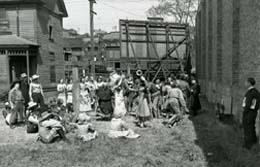On May 10, 1939, actors from the Seattle Unit of the Federal Theatre Project join hundreds of Vancouver, Washington, citizens to present a historical pageant, Flotilla Of Faith. The pageant reenacts the arrival to Fort Vancouver of Catholic missionaries Father Francis Norbert Blanchet (1795-1883) and Abbe Modeste Demers (later the first Bishop of Vancouver Island), and celebrates the 100th Anniversary of Catholicism in the Pacific Northwest. The Theatre Project's National Director Hallie Flanagan calls it "the greatest religious festival ever staged in the Northwest" (Flanagan, p. 311).
Although the pageant celebrated May 3, 1838, as the date on which the priests arrived, Blanchet and Demers actually arrived on November 24, 1838.
Fort Vancouver, a large Hudson's Bay Company settlement, was situated on the site of present-day Vancouver, Washington. The Federal Theatre Project (1935-39) was a work-relief program for theater professionals funded by the Works Progress Administration. The pageant was put on as the Federal Theatre Project's unsuccessful battle for Congressional funding was drawing to a close. The pageant was written by Douglas Wright and directed by Edwin O'Connor and Jan Norman.
Bishop Gerald Shaughnessy (1887-1950) suggested the Seattle Federal Theatre Project to the Archdiocese as a partner in the venture. Father Shaughnessy, Bishop of Seattle, was dedicated to spreading the faith through grass-roots methods such as street preaching and traveling trailer chapels that could be hauled to remote locations. Catholics at the time made up only about 10 percent of the population in Washington and Oregon, and there was considerable anti-Catholic sentiment throughout the region (Witham, 140).
The Federal Theatre Project was partnered with the Vancouver Chamber of Commerce and the Catholic church in Washington and Oregon.
Participating in the pageant were 45 Project actors (men and women) who shared the roles with church officials and several hundred Vancouver citizens. The Federal Theatre Project actors traveled from Seattle to Vancouver in full costume and with a State Patrol escort in order to generate publicity. In Hallie Flanagan's words:
"Bateaux landing at the banks of the Columbia River found waiting celebrants from ecclesiastical provinces embracing the archdiocese of Oregon and the dioceses of Seattle, Spokane, Great Falls, Boise, Baker, and Alaska. Among the many church dignitaries were the personal representatives of Pope Pius XII, and his Eminence the Cardinal Archbishop of Quebec" (Flanagan, 312).
The Flotilla of Faith featured four bands, more than 200 costumed actors, horses, and a wagon team. The many props included pistols, rifles, and cannon. The pageant was broadcast over the NBC Red network, a radio network that featured mainly music and entertainment, and it was filmed for newsreel by Universal.
An audience of more than 8,000 spectators, joined by local Native American dancers, participated in the post-production potlatch feast.

